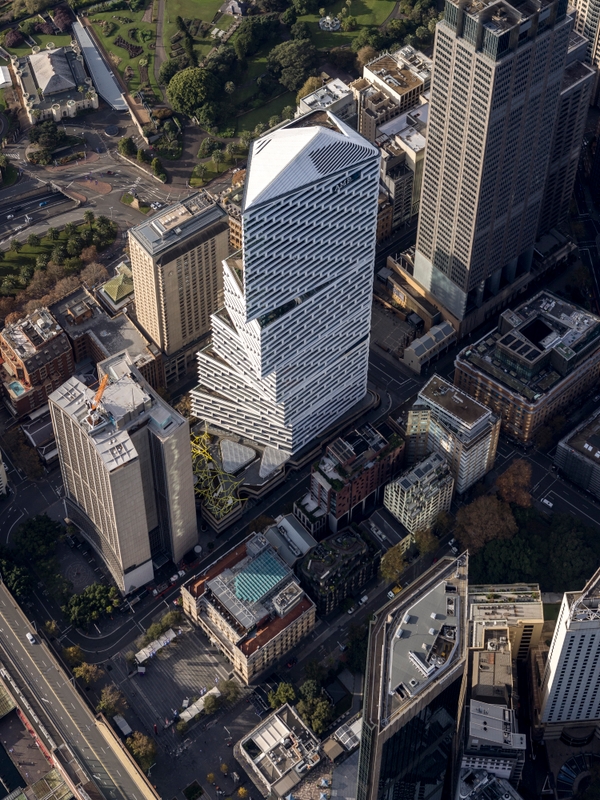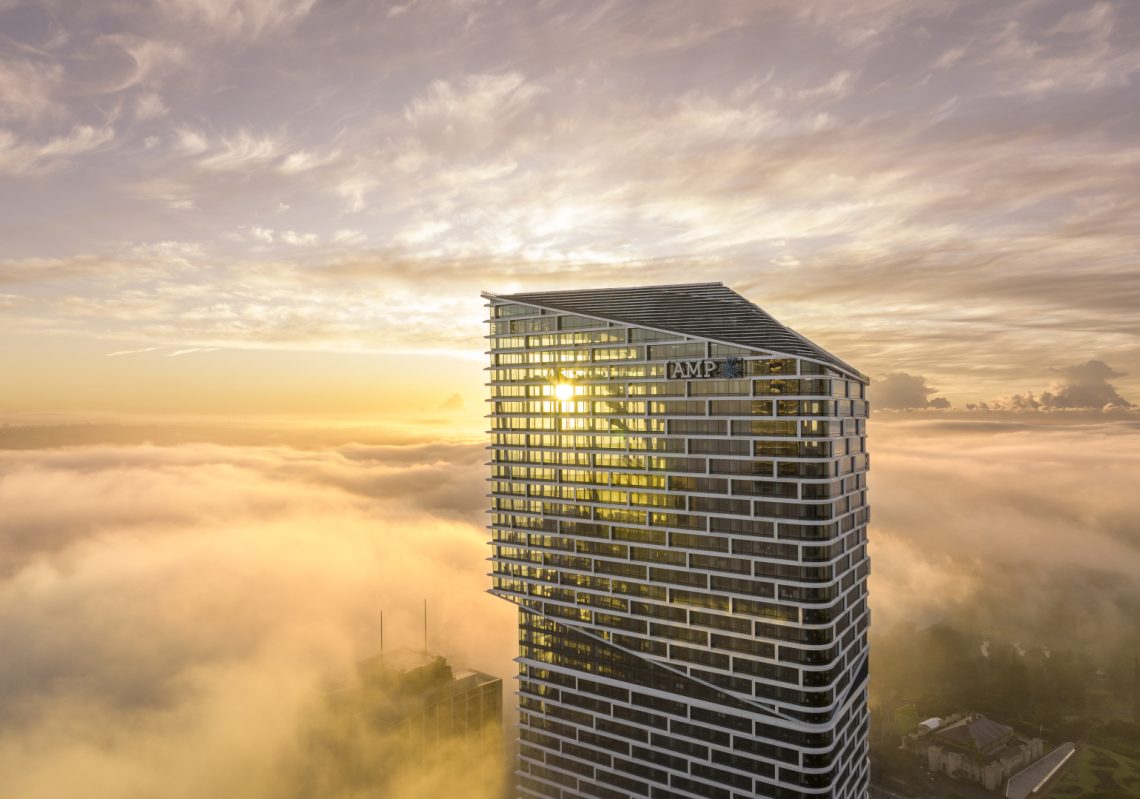A new skyscraper on Sydney’s Circular Quay has a longer history than its gleaming new facade and up-to-the-minute design might suggest.
When the AMP Centre, an oblong monolith of glass and concrete overlooking Circular Quay at 50 Bridge Street, was completed in 1976, it was the tallest building in Sydney.
Martin Place’s new MLC Centre would snatch the title the following year, and time and a growing Sydney skyline have overtaken the once imposing skyscraper in other ways.
As the AMP Centre approached its half-century anniversary, it was also approaching the end of its life. That meant, said Arup Principal Robert Saidman, the owners AMP Capital had some pretty serious thinking to do.
“They had quite a challenge with the existing building,” he said. “When we first looked at it around 2010 or 2011, it had an original façade, which was prone to a lot of leakage. It had pretty poor performance generally; with all the glazing technology that has evolved, it had started to fall well behind its peers. Its mechanical systems were ageing and inefficient; it had very poor air distribution; and its water and energy performance weren’t great.”
But rather than quietly retiring a structure that was approaching obsolescence, AMP Capital sought to “upcycle” the building, working with Arup, structural engineers BG&E and architects 3XN and BVN to preserve much of the original structure while creating something entirely new.

“The basis of the scheme, in simple terms, involved removing the northern portion of the existing building up to the edge of the existing core, and then extending new floor plates to the north,” Saidman said.
The result preserved 65 per cent of the existing floor plates and 98 per cent of the core, while approximately doubling the net lettable area of the tower and creating a distinctive spiralling look to the skyscraper, as if five separate blocks were twisting around its axis.
The outcome: a saving of 12,000 t of embodied carbon, which BG&E says is the equivalent of 70,000 flights between Sydney and Melbourne. The tower has been accredited with a 6 Star Green Star O ce Design v3 by the Green Building Council of Australia and is designed to be capable of achieving a 5.5 Star NABERS Office Base Building Energy Rating.
But it is not just its green credentials that have captured attention. Quay Quarter Tower was named World Building of the Year at the 2022 World Architecture Forum and was a national finalist in the 2022 Engineers Australia Excellence Awards, as well as being recognised by such industry groups as Urban Taskforce and the NSW Master Builders Association.
Channeling the past
Bringing 21st century construction methods to a 1970s skyscraper is not a straightforward process.
To work with the structural elements they wanted to maintain, the engineers first had to dive into the past.
“We needed to understand the existing building,” Reza Hassani, BG&E Seniors Associate, Structures, told create.
“We had a set of existing drawings, but they were design drawings — they weren’t as-built drawings. First … we needed to verify the as-built condition of the structure and compare it to the existing drawings that we had.”
That required gaining a full understanding of the building’s geometry using 360-degree cameras to create a full-point cloud survey: the sizes of the columns, the thicknesses of the walls and slabs, whether certain features had been built as the plans showed or whether they were offset by even 100 mm.
“In terms of the materials, we needed to understand the strength of materials and also their durability,” Hassani said, adding that the team took 1600 core samples of concrete from the building. “The other test you need to do is the durability test. Durability tests show how much concrete has degraded through time; usually it degrades because of a chloride diffusion.
“The chloride exists in the seawater, and because this structure is close to the harbour and seawater, the chloride degrades the quality of concrete. We tested that and we made sure that the structure will still be safe in another 50 years.”
The team also tested for carbonation, Hassani said.
Adding to the challenge, the team needed to begin construction before the testing was complete. The engineers conducted their first tests at the concept stage 10 years ago and continued them until the project’s completion.
“You don’t have the luxury of doing a full scheme test on the structure because the structure was under service when we started doing the concept design. The concept design of this structure started 10 years ago and the building was used by AMP — by lawyers and banks,” he said. “Most of the testing was conducted after the building was evacuated in 2017. We had designed the structure; we needed to go and confirm. We tested some areas where the strength was better than our assumption, and some areas the strength was lower than our assumption. We had to redesign and recheck.”
Saidman said much of Arup’s work involved understanding the decisions various engineers made throughout the life of the building.
“For us, it was from a building services perspective and a façade perspective — so lots of time digging through drawings, crawling around site, and then understanding why did they arrange the composition of the building as they did,” he said.
Arup Associate Principal Ryan Crabbe agreed.
“You do get into the head of the previous designers a bit,” he said.
“You unpick it and you can see why they made certain decisions and you can see how they augmented the design over time.
Turning around
The distinctive design of the building also offered challenges, from the use of inclined columns, which required the core to support additional horizontal forces, to the way that the tower’s rotating form meant there was no such thing as a “typical” floor.
“It means that it’s a lot of effort for the engineer and the design and construction team,” Hassani said. “You can’t replicate your design, for example, from level 21 to level 22, so that means a lot of effort. But what we’ve done with this building, we’ve modelled every piece of the structure and we’ve designed and analysed [them] as individual or independent elements … We had to design every floor and every column and every wall as a different package.”
BG&E also had to oversee the tower’s cantilevered floors, which were designed to maximise floor space but also had to be built so as to not overshadow the nearby Royal Botanic Gardens.
“We had to build inclined columns and hanging columns to satisfy the architectural intention of the northwest corner of the building cantilevering out,” Hassani said. “We built a temporary cantilevered platform, which was sitting on rails and on the level below, and there were construction workers pushing it out. It was a temporary construction platform so the construction team could stand on that platform and build the top floor.”
The ingenuity extended to the tower’s interior, too.
“We proposed a double deck lifting system with two lifts locked together, and that allowed passengers on consecutive floors to use the elevators simultaneously,” Saidman said. “To achieve this required a split-lobby design approach with an upper and lower deck to allow simultaneous loading of two cars. What that achieved was that enabled the design team to save nine lift shafts compared to a traditional system, representing about 120 m2 of space per floor.”
That, Saidman said, was the world’s first ever instance of a double-deck lifting system being retrofitted into a commercial building, and it permitted the team to reduce the size of the tower’s core, adding to the embodied carbon savings.
Concrete savings
Although Quay Quarter Tower’s embodied carbon savings — totalling 12,000 t — are impressive, they were not originally a priority for the engineers. At the time, they were thinking about the overall project feasibility that could be realised by reusing part of the structure.
“This was conceived back in 2011, and back then embodied carbon was not considered nearly as much as a design input as it is today,” Saidman said. “The outcomes were fantastic, but as a design target, it wasn’t established that we want to achieve specific kilograms of CO2 per square metre for the building.
“But we are doing that now, so it would be interesting to see, would we have done somethings differently and pushed the outcome even harder?”

When it comes to minimising carbon emissions, Hassani said, rule one is to retain as much of the structure as possible. But Quay Quarter Tower had additional sustainability approaches.
“We used the greenest possible concrete — the minimum embodied carbon,” he said.
“We worked with concrete suppliers to come up, as much as possible, with a green structure. Also in the new structure, we used a lot of steel members — steel columns and steel beams — and steel is a much greener material compared to concrete, because steel is recyclable.”
Efficiency in the building’s services also added to its sustainability, as did the façade, which uses high-performance glazing and sunshades to deliver a 30 per cent reduction in solar radiation while still maintaining the building’s stunning views of Sydney Harbour.
“The façade was a great success, generally, from an amenity and operational carbon perspective,” Crabbe said. “A lot of work went into that shading and the horizontal and vertical form.”
And the engineers took a “right-sizing” approach, which disavowed unnecessarily oversizing equipment.
“Designing the façade loads down as much as we can to get better façade performance; the mechanical chilled beams that we’ve got around the perimeter are all smaller; the pipework going to them is smaller; the chillers and the equipment are all smaller,” Saidman explained. “That’s an embodied carbon benefit at the end of the day: just by designing efficiently you need less equipment to meet the capacity of the building.”
Back and forth
Part of the success of the project, Hassani said, came from the highly detailed instrumentation dispersed throughout the building during its construction.
“This was the first time engineers were designing such a thing,” he said. “There hasn’t been any tower upcycled with this extension at this height. We have the engineering principles, but this building is unique.”

To ensure the real-life structure of concrete and steel matched the complicated models with which the engineers were working, BG&E sought data on everything it could.
“We were measuring the building inclination, building frequency, and we were calibrating our structural models on a weekly basis, making sure that our structural model was a good representative of site condition,” Hassani said.
“Instrumentation is common for bridges and dams: they use it a lot because they are public assets and there are lots of factors you need to consider. With buildings, we don’t do that much. We just do a few surveying measurements.
“But with this building, we had tilt sensors, accelerometers — for the safety of the structure and also for calibrating our structural analysis and making sure that our digital twin in our software was a good representative of the construction site.” This led to one particularly satisfying moment for Hassani.
Because Quay Quarter Tower was being demolished and rebuilt simultaneously, its centre of mass shifted over time — and the team estimated how significant this shift would be.
“When we demolished the building, the building moved to the south because the centre of mass was changing, and when we rebuilt it, the building started moving to the north,” Hassani said. “After four years of construction and building — demolishing, building, demolishing, building — we measured … it was right on spot. It was plus or minus 20 mm.




Congratulations on paying attention to a well located icon and giving ITV’s new life with a sensible and creative renovation. There are so many such meedycproperties awaiting your skills here in the USA!